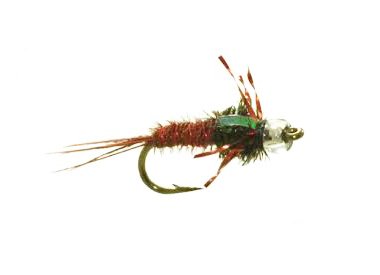The pheasant tail nymph recipe is a classic fly fishing pattern that imitates a variety of aquatic insects. To tie a pheasant tail nymph, you will need pheasant tail feathers, copper wire, peacock herl, and a nymph hook.
Fly fishing enthusiasts often turn to the pheasant tail nymph when targeting trout in rivers and streams. This versatile pattern can be tied in different sizes and variations to match the specific insects present in the water. The natural appearance and effective design of the pheasant tail nymph make it a go-to choice for many fly anglers.
We will provide a step-by-step guide on how to tie this productive fly pattern, along with tips for customizing it to suit various fishing conditions. Whether you’re a seasoned fly tyer or a beginner looking to expand your skills, mastering the pheasant tail nymph recipe will undoubtedly enhance your fly box arsenal.

Credit: www.reddit.com
The Pheasant Tail Nymph: An Introduction
The Pheasant Tail Nymph is a versatile fly pattern that imitates mayfly nymphs and can be tied in various sizes and colors. Originating in the 1950s, it was created by English fly tier Frank Sawyer. Its simplicity and effectiveness have made it a staple in fly fishing. The natural look of the pheasant tail fibers makes it a reliable pattern for catching trout in various water conditions. Its ability to sink quickly and imitate the appearance of a mayfly nymph makes it an ideal choice for anglers. This fly pattern can be adapted to match specific insect species and has become a key component in the arsenal of many fly fishermen.
Ingredients For The Pheasant Tail Nymph
The Pheasant Tail Nymph is a classic fly pattern that imitates a wide range of underwater insect life. For tying this effective fly, you will need a few key ingredients. Pheasant tail feathers are the primary material, providing natural color and movement. The pattern also requires the use of a sharp hook and thread, necessary for securing the other materials. In addition, some additional materials such as ribbing wire, beads, and dubbing are used to enhance the effectiveness of the fly and give it a lifelike appearance.
Step-by-step Instructions For Tying The Pheasant Tail Nymph
Learn how to tie the Pheasant Tail Nymph with our step-by-step instructions, a must-have fly fishing recipe. Perfect for targeting trout in various water conditions, this pattern is easy to tie and highly effective on the water.
| Preparing the Pheasant Tail | To begin tying the Pheasant Tail Nymph, prepare the materials by selecting 4-6 long, natural pheasant tail fibers. Trim the tips of the fibers to ensure a clean and uniform length. Strip away any excess fluff from the fibers, leaving only the long, slender strands. |
| Securing the Hook and Thread | Attach a size 14 or 16 nymph hook to the vise and secure it firmly. Start the thread at the eye of the hook and wrap it down the shank towards the bend. Make sure the thread is secure and lays flat along the hook. |
| Building the Body | Begin forming the body of the nymph by dubbing a thin layer of natural hare’s ear dubbing onto the thread. Wrap the dubbed thread around the shank, creating a tapered shape towards the bend. Secure the dubbing with multiple turns of thread and trim any excess. |
| Adding Tails and Ribbing | Take the prepared pheasant tail fibers and tie them in at the bend of the hook. Use a few tight wraps to secure the fibers, making sure they extend slightly beyond the body. Next, take a fine copper wire and wrap it tightly around the body in evenly spaced turns. This will add durability and attractiveness to the nymph. |
| Finishing Touches | Create a neat, tapered head by building a small thread dam behind the hook eye. Whip finish the thread and trim off any remaining material. Apply a small drop of head cement to secure the wraps. The Pheasant Tail Nymph is now ready to be fished and can be highly effective for enticing trout in various fishing scenarios. |

Credit: www.amazon.com
Tips And Techniques For Success
|
Selecting the Right Pheasant Tail Feathers: When tying a pheasant tail nymph, it’s crucial to use high-quality feathers. Look for long, slender feathers with well-defined markings and a good range of colors to create realistic imitations. Choosing the Proper Hook Size: The hook size you select for your pheasant tail nymph will depend on the type of water you’ll be fishing in and the size of the insects in the area. Match the hook size to the natural insects present to increase your chances of success. Adding Variation and Experimenting: To make your pheasant tail nymphs more effective, consider adding variation to the pattern. Experiment with different colors, sizes, and materials. Sometimes a subtle change can make all the difference in enticing wary fish to strike. |
The Pheasant Tail Nymph: Effective Strategies
The Pheasant Tail Nymph is a versatile fly pattern that can be highly effective in a variety of fishing situations. Here are some tips on when and where to use this fly, as well as techniques for fishing with it:
When And Where To Use The Pheasant Tail Nymph
The Pheasant Tail Nymph is particularly productive when fish are feeding on small aquatic insects such as mayflies and caddisflies. It can be successful in both rivers and stillwaters. Try using it during the early morning or late evening when insects are most active.
Techniques For Fishing With The Pheasant Tail Nymph
One effective technique is to fish the Pheasant Tail Nymph as a dropper below a dry fly. Cast your line upstream and let the nymph drift naturally with the current. Another method is to use an indicator to detect subtle strikes and fish the nymph as a suspended bait. Vary your retrieve speed and use short, quick strips to imitate the movement of an insect.
Remember to experiment with different sizes and colors of the Pheasant Tail Nymph to match the insects present in the water. With its realistic appearance and lifelike movement, this fly can be a go-to choice for many fly anglers.

Credit: bluequillangler.com
Frequently Asked Questions For Pheasant Tail Nymph Recipe
What Hook For Pheasant Tail Nymph?
The recommended hook for a Pheasant Tail Nymph is a curved or straight nymph hook, typically in sizes 12 to 18. This versatile pattern imitates a wide range of aquatic insects and works well in various fishing conditions.
What Is The Best Size Pheasant Tail Nymph?
The best size Pheasant Tail Nymph is typically #12-16 for general fishing. The size may vary based on specific conditions and preferences.
What Does A Pheasant Tail Nymph Imitate?
The Pheasant Tail Nymph imitates a variety of aquatic insect larvae, such as mayflies and stoneflies.
How Do You Tie A Beadhead Pheasant Tail Nymph?
To tie a beadhead Pheasant Tail Nymph, follow these steps: 1. Start with a beadhead and thread. 2. Tie in some pheasant tail fibers as the tail. 3. Add copper wire and dubbing for the body. 4. Use a hackle feather for the legs.
5. Finish with a whip finish knot.
Conclusion
Crafting your own pheasant tail nymph is an essential skill for any fly angler. By following this simple recipe, you can create a highly effective fly that imitates the natural nymphs and entices fish to strike. The combination of materials and techniques used in this pattern ensures its success in various fishing conditions.
So, whether you’re a beginner or a seasoned angler, make sure to give this pheasant tail nymph recipe a try and elevate your fly fishing game.

